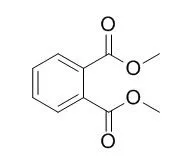| J Hazard Mater. 2014 Apr 30;271:202-9. |
| Degradation of dimethyl phthalate in solutions and soil slurries by persulfate at ambient temperature.[Pubmed: 24637446] |
The degradation of Dimethyl phthalate (DMP) by persulfate at ambient temperature (T=20-40°C) was investigated in aqueous solutions and soil slurries to assess the feasibility of using persulfate to remediate Dimethyl phthalate contaminated soil and groundwater.
METHODS AND RESULTS:
First, the effects of temperature, initial oxidant concentration, initial Dimethyl phthalate concentration and initial solution pH on the removal of Dimethyl phthalate and TOC were studied in aqueous solutions. The results show that persulfate at 40°C can effectively mineralize Dimethyl phthalate. Furthermore, dimethyl 4-hydroxyl phthalate, maleic acid and oxalic acid were identified as the degradation intermediates, and degradation pathways were proposed. Lastly, persulfate at 40°C was applied to remediate soil spiked with Dimethyl phthalate at ∼ 600 mg/kg. The results show that persulfate at 40°C is highly effective for the remediation of Dimethyl phthalate contaminated soil.
CONCLUSIONS:
Overall, this study provides fundamental and practical knowledge for the treatment of emerging phthalate esters (PAEs) contaminated soil and groundwater, as well as PAEs contaminated industrial wastewater, with persulfate at ambient temperature. |
| Eur Rev Med Pharmacol Sci. 2010 May;14(5):443-8. |
| Laboratory evaluation of dimethyl phthalate treated wristbands against three predominant mosquito (Diptera: Culicidae) vectors of disease.[Pubmed: 20556923] |
METHODS AND RESULTS:
The repellent efficacy of Dimethyl phthalate (DMP) treated wristband was determined against mosquitoes, viz Anopheles stephensi Liston, Aedes aegypti Linnaeus, Culex quinquefasciatus Say at two concentrations viz., 1.5 and 2.0 mg/cm2 under the laboratory conditions. DMP treated wristband had shown variable degrees of repellency impact against different mosquito species.
Its offered higher reduction of man landing rate against Anopheles stephensi at both concentrations of 1.5 (81.1%) and 2.0 mg/cm2 (87.0%). 79.8% and 84.8% of protection achieved against Culex quinquefasciatus at concentrations of 1.5 and 2.0 mg/cm2, respectively. 74.4 and 86.5% of reduction of man landing rates were obtained against Aedes aegypti at concentrations of 1.5 and 2.0 mg/cm2 respectively. The reduction of man-landing rate evaluations were confirmed by t-test compared between control group and each experimental group. The t-test result shows at 1.5 (p = 0.0026; t = 19.2; df = 2) as well 2.0 mg/cm2 (p = 0.0025; t = 19.8; df = 2) are extremely significant to reduce the man vector contact.
CONCLUSIONS:
The present data suggest that DMP treated wristbands are most promising against both day and night-biting mosquitoes and significantly reducing the man-vector contact. Therefore, it could serve as a potential as means of personal protection device against insect nuisance biting and insect-borne disease when and where other kinds of personal protection measures are impossible and impracticable. |
| Environ Sci Pollut Res Int. 2014 May;21(10):6571-7. |
| Kinetic study of the removal of dimethyl phthalate from an aqueous solution using an anion exchange resin.[Pubmed: 24510529] |
Phthalate acid esters are becoming an important class of pollutants in wastewaters. This study addresses the kinetics of removal of Dimethyl phthalate (DMP) using the anion exchange resin D201-OH from an aqueous solution.
METHODS AND RESULTS:
The effects of various factors on the removal rate and efficiency were investigated. An overall initial removal rate (OIRR) law and a pseudo first-order kinetic (PFOK) model were also developed. The internal diffusion of Dimethyl phthalate within the resin phase of D201-OH is the rate-controlling step. Optimization of the particle size and pore structure of the resin D201-OH, the Dimethyl phthalate concentration, and the reaction temperature can improve the Dimethyl phthalate removal rate. The hydrolysis reaction of Dimethyl phthalate catalyzed by D201-OH indicates an overall reaction order of 1.76, a value that is between the first order and the second order. The apparent activation energy of the reaction is 34.6 kJ/mol, which is below the homogeneous alkaline hydrolysis activation energy of 44.3 kJ/mol. The OIRR law can quantify the initial removal rate under different conditions. The results also show that the theoretical Dimethyl phthalate removal efficiency predicted by the PFOK model agrees well with the experimentally determined values.
CONCLUSIONS:
Our research provides valuable insights into the primary parameters influencing the kinetic process, which enables a focused improvement in the removal or hydrolysis rate for similar processes. |






 Cell. 2018 Jan 11;172(1-2):249-261.e12. doi: 10.1016/j.cell.2017.12.019.IF=36.216(2019)
Cell. 2018 Jan 11;172(1-2):249-261.e12. doi: 10.1016/j.cell.2017.12.019.IF=36.216(2019) Cell Metab. 2020 Mar 3;31(3):534-548.e5. doi: 10.1016/j.cmet.2020.01.002.IF=22.415(2019)
Cell Metab. 2020 Mar 3;31(3):534-548.e5. doi: 10.1016/j.cmet.2020.01.002.IF=22.415(2019) Mol Cell. 2017 Nov 16;68(4):673-685.e6. doi: 10.1016/j.molcel.2017.10.022.IF=14.548(2019)
Mol Cell. 2017 Nov 16;68(4):673-685.e6. doi: 10.1016/j.molcel.2017.10.022.IF=14.548(2019)